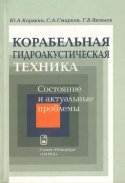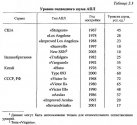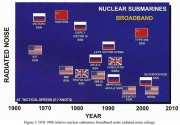Think about it this way. The last Victor class subs came out 30 years ago and had the same hull diameter as 093A (or maybe even less)
These were considered to be as quiet as the earliest Akulas. Who despite much large hull, weren't quieter than the last Victor III class based on those public charts we've seen.
No, don't think about it this way. "Earliest Akulas" and "last Victors" aren't comparable. Decibels are not a linear quantity. Sonar physics is not intuitive.
Submarines:
Victor III is either Project 671RTM or 671RTMK, which is an upgraded version of Project 671RTM.
First boat of RTMK series (K-292) was laid down in 1986 in Leningrad however first boat of the RTM series (K-524) was laid down in 1976 in Leningrad.
Akula is Project 971. (note: "Improved Akula" is a single ship Project 9711 (or 971.1) sometimes described as 971M. Project 971I is
not "Improved Akula")
First boat (K-284) was laid down in 1983 in Komsomolsk-on-Amur and entered service in 1984. 8 submarines total were built in that shipyard and 6 more in Severodvinsk. Akulas number 2 and 3 were laid in both shipyard in 1985 and entered service in 1987-88.
The first Akula was particularly noisier than the subsequent ones because it was a test ship which is why it was decommissioned in 2001, before all others.
In general 671RTMK never got close to the noise level of 971. The improvements on RTMK did not affect the most important design elements which were mostly consistent with 671RTM. There were some improvements in manufacturing, especially using the newly acquired machines but they only went so far. RTMS were manufactured to keep up the numbers and they could be built in Leningrad which was the third nuclear shipyard after Severodvinsk and Komsomolsk serving Northern and Pacific fleets respetively. 971 was both built using new technology and new design principles but it was a new process that took time and never got implemented outside of the two.
971 as a class was all-around quieter at all speeds compared to 671RTMK.
Decibels:
Source:

Table:

The values in the table are notional reference values
above 100dB level i.e. Akula has noise level not of 37dB but 137dB etc, Sturgeon not 45 but 145 etc.
Decibels are a
relative measure not an absolute measure and they describe a
logarithmic scale of magnitude. For example 10dB difference in acoustic pressure between sources indicates 10x energy (power) and 3x
amplitude differential.
It means that if a source of noise is louder by 10dB it is "three times as loud". However wave energy dissipation affects the
distance at which a signal can be detected which is why "relative subjective loudness" which is how humans hear sound is not used in sonar.
Victor I (Project 671) at 172dB was louder than Victor III (Project 671RTMK) at 148dB by 24dB which is more than 20 times. It's similar to the difference in loudness between Akula (Project 971) and Severodvinsk (Project 885). And while in absolute terms a submarine generating 172dB noise will be heard across an ocean - which is how SOSUS was able to detect Soviet submarines at extreme ranges - the relative ability of a Sturgeon (145dB) to detect a Victor I (172db) is somewhat comparable to the ability of the Severodvinsk (117dB) trying to detect the Akula (137dB).
Sonar:
The ability to detect a signal is affected by the level of noise generated by the detecting submarine as well as the background noise level in the medium. I won't cite formulas and explanations because of character limit.
When thinking about sonar you need to think in geometrical rather than numerical terms. Imagine circles indicating dB ranges of source and sensor that overlap or not on a map. Also the most intuitive notion for detecting objects for humans is
vision which is a horrible analogy for
sound.
These publicly available charts are not reliable. They only indicate some arbitrary notional parameter which is referenced in literature for academic reasons - to explain sonar mechanics, compare different acoustic solutions etc.
The actual noise level of a submarine is not a single value but a series of values measured in different frequencies. The single value usually refers to low frequency noise that is used to test long range detection capabilities of passive sonar. But this is not how submarines use sonar in regular operation. Sonars search (now: automatically) through entire ranges, use libraries. Noise changes depending on speed as well as the water characteristics.
Those notional "noise levels" are nowhere near the amount of data that is necessary to make a claim on
detectability which is what matters. Even something as simple as having a sonar with greater sensitivity can improve the situation when you can reduce speed to cut down own noise to detect your target.
If you can detect a submarine traveling at 15 knots from 200 miles but can't when it reduces speed to 5 knots then what good is it if your search area changes by tens of miles in all directions with each hour?
Do you know how Soviet submarines were being detected in the 1950s, 1960s, 1970s and 1980s and how detection methods and tactics evolved? It's an entire field of engineering which underwent very radical change.
And that's all beside the point of understanding actual missions and tactics that submarines use which is very much not what you read/watch in "The Hunt for the Red October" or similar entertainment. Those ideas were shaped by the experiences in the 60s and 70s which were very different compared to later era. It was the period of very significant gap in capabilities between USN and Soviet navy - not only in terms of technology but also fleet structure - as well as a period of very intensive innovation in sonar. It's like trying to apply WW2 dogfighting in Battle of Britain to 1990s air combat over Iraq.
So yes, a 09III can in theory reduce its
referential noise level to within 5dB above 688i and more if equipped with a pump-jet. But what of it? What does it solve
exactly? What's the point of pointless discussions?
Anyway, this is clearly a waste of time...




